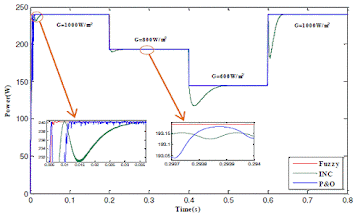ABSTRACT:
In this paper, we present a modeling and simulation
of a standalone hybrid energy system which combines two renewable energy
sources, solar and wind, with an intelligent MPPT control based on fuzzy logic
to extract the maximum energy produced by the two PV and Wind systems.
Moreover, other classical MPPT methods were simulated and evaluated to compare
with the FLC method in order to deduce the most efficient in terms of rapidity
and oscillations around the maximum power point, namely Perturb and Observe
(P&O), Incremental Conductance (INC) for the PV system and Hill Climbing
Search (HCS) for the Wind generator. The simulation results show that the fuzzy
logic technique has a better performance and more efficient compared to other
methods due to its fast response, the good energy efficiency of the PV/Wind system
and low oscillations during different weather conditions.
KEYWORDS:
1.
Hybrid energy system
2.
MPPT
3.
Fuzzy Logic Control (FLC)
4.
Wind system
5.
Photovoltaic system
6.
PMSG
SOFTWARE: MATLAB/SIMULINK
Fig. 2. PV generator output power for different MPPT techniques.
Fig. 3. PV generator output voltage for different MPPT techniques.
Fig. 4. Mechanical power of wind turbine for different MPPT techniques.
Fig. 5. Power coefficient (Cp) for different MPPT techniques.
CONCLUSION:
REFERENCES:
[2]
C. Marisarla and K.R. Kumar, “A hybrid wind and solar energy system with
battery energy storage for an isolated system,” International Journal of
Engineering and Innovative Technology, vol. 3, n°3, pp. 99-104, ISSN 2277-3754,
September 2013.
[3]
L. Qin and X. Lu, “Matlab/Simulink-based research on maximum power point
tracking of photovoltaic generation,” Physics Procedia, 24, pp.10- 18, 2012.
[4]
B. Bendib, F. Krim, H. Belmili, M. F. Almi and S. Boulouma, “Advanced fuzzy
MPPT controller for a stand-alone PV system,” Energy Procedia, 50, pp.383-392,
2014.
[5]
H. Bounechba, A. Bouzid, K. Nabti and H. Benalla, “Comparison of perturb &
observe and fuzzy logic in maximum power point tracker for pv systems,” Energy
Procedia, 50, pp.677-684, 2014.




